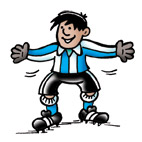Do Goalkeepers Stand a Chance Against a Penalty Kick?
 If you’re a football fan then you’ll be able to relate to the agonies of watching penalty shootouts when used to decide a game. Personally, when my team’s goalie is facing down a striker, I usually find myself standing up fists clenched and trying with my mind to actively will the goalkeeper to save the kick. But does a goalie ever stand a chance and what can he do to help himself ?
If you’re a football fan then you’ll be able to relate to the agonies of watching penalty shootouts when used to decide a game. Personally, when my team’s goalie is facing down a striker, I usually find myself standing up fists clenched and trying with my mind to actively will the goalkeeper to save the kick. But does a goalie ever stand a chance and what can he do to help himself ?
Whoever decided to put the penalty spot twelve yards from the goal-line when penalties were first introduced into soccer in 1891 knew something about human reactions. It takes around half a second for a typical penalty kick to travel that distance – which just happens to be the typical reaction time of humans.
To get some idea of the scale of the challenge confronting a keeper trying to save a penalty, get a coin and hold it at shoulder height. In the time taken for the coin to reach the floor, the keeper is supposed to work out where the ball is going, get to it and stop it.
The upshot is that keepers don’t have much chance of saving a penalty unless they can find a way of anticipating where the ball is going to go. Statistics suggest that goalkeepers save just 1 penalty in 5 during UEFA football championships – around thirty per cent of which have been decided on penalties.
STRIKER ‘TELLS’ – “It’s all in the hips baby”
Studies of the world’s best keepers show that they typically make their first move around 100 milliseconds before the ball is struck and base their actions on the position of the legs and feet of the striker.
Research by sports scientists has shown that the most valuable clues are to be found in the orientation of the hips and feet. Analysis shows that just before they take the kick, strikers usually plant their non-striking foot in the direction of the final kick. According to Professor Ian Franks and colleagues at the University of British Columbia, this “Watch the Other Foot” rule holds true around 80-85 per cent of the time. Better still, it buys the keeper as much as 200 milliseconds to prepare before the kick is taken. For a ball struck at over 50mph, that translates into a half a goal-mouth’s worth of distance – and the difference between victory and defeat.






